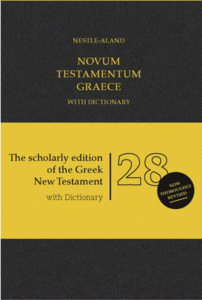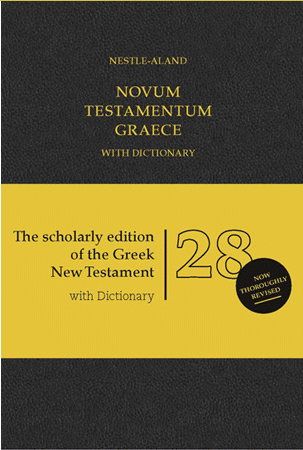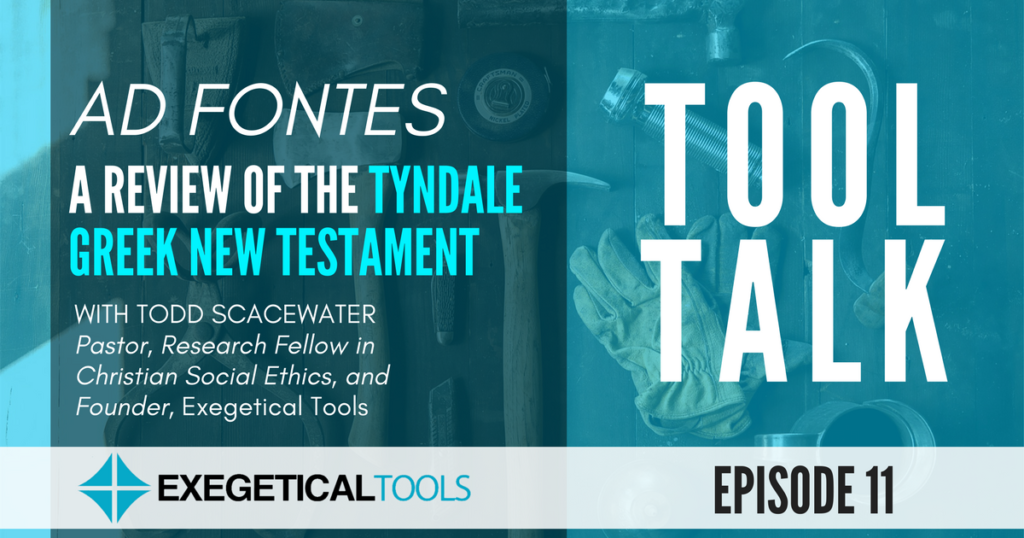 Most people don’t have a supernatural store of discipline. In order to maintain their Greek, these normal folk are going to need good routines and good tools. One of the best ways to motivate yourself to keep reading Greek is to choose the right Bible.
Most people don’t have a supernatural store of discipline. In order to maintain their Greek, these normal folk are going to need good routines and good tools. One of the best ways to motivate yourself to keep reading Greek is to choose the right Bible.
There are several different types of Greek Bibles and all have strengths and weaknesses.
Reader’s Bibles
First, there are New Testament reader’s Bibles, such as Zondervan’s (review here) and UBS’s, which footnote all words occurring, say, 30x or less and have a dictionary in the back for more common words. Zondervan’s edition has the advantage of being thin and light, while the UBS text has the advantage of providing parsings for verbs. Also available is a Septuagint reader’s Bible from Hendrickson, which will introduce you to a wider range of vocabulary words and also lure you into the mysterious world of Septuagintal studies.
These Bibles are good for sitting down with just the Greek text and trying to work through without needing a dictionary. The downside to these is that you can get stuck on difficult grammar or syntax and you will have to open an English Bible or Bible software to figure it out.
Greek-English Parallels
Second, there are Greek-English parallels, such as the Nestle-Aland’s (27th ed.) older RSV parallel, which comes in a nice flexicover and good binding. This edition includes the Greek and English text on adjacent pages, with a critical apparatus for Greek and for English, meaning the English apparatus translates the Greek variants for you, which can be quite helpful for forms you are unfamiliar with. There is also the newer 28th ed. which comes with both the NRSV and NEB as parallel English texts, but this makes the Bible run 1,700 pages and there is no English apparatus. Zondervan recently published a UBS5/NIV parallel Bible, which uses a slightly larger font size, sports a durable flexicover, and contains the UBS apparatus that ranks textual variants from A (certain) to D (very uncertain). It is a nice desk volume for reading chapters at a time, but also spans 1,700+ pages, making it slightly difficult to carry around.
Crossway has put out a Greek-ESV parallel Bible with the NA-28 text and a Greek apparatus, but the font size is unnecessarily large, causing the book to be very undesirable to carry around and large in size (all three dimensions). The cloth cover is nice but it also stains very easily, even if a small bit of water touches it (which happened to both my Greek and German parallel Bibles the first week I owned them). I have seen some Kindle edition parallels, including one by Crossway, but it includes the NA-27 text and lays out the Greek and English on top of each other, one verse at a time, rather than on parallel pages, which would make it impossible not to glance at the English.
The advantages of these texts is that you will get immediate help with grammar or syntax you can’t figure out and you may be encouraged to read more Greek, knowing that if you get exhausted you can simply switch to the English. The downside is that you will always be tempted to look at the English translation too quickly before wrestling with the Greek yourself, and you will miss out on many insights about the Greek language because you were too impatient. Another downside is that the only help with vocab you get is to glance at the English translation’s gloss, which will not necessarily give you a semantic range with which you can figure out the meaning of the word in context for yourself as you could with the reader’s editions.
Plain Greek Bible
Lastly, there is your plain ol’ Greek Bible. There is the NA-28 leather-bound text with dictionary, which runs 1,100 pages (not bad for a Bible), and there are of course variations on that text, including different covers (hardback is cheaper). An alternative is the UBS5 hardback text, which differs mainly by having a smaller apparatus and some different conventions for signalling quotations, for example. The new kid on the block is the Tyndale House Greek New Testament, which uses its own method of determining the text (privileging the earliest readings), is slim and pleasurable to read (although I’m not a huge fan of the Greek font), and even has some unique features such as ekthesis to mark new units and some spelling that imitates that of the early manuscripts rather than our Greek grammar vocabulary lists (read more in our review).
If you are a very disciplined person, this is probably the route for you. With a dictionary in the back, you can look up any words you do not know, which will help you learn vocabulary better (the more effort something takes you, the more successfully you will remember it, generally). Since there is no English parallel, you will have to wrestle with the grammar and syntax yourself, perhaps having a copy of Wallace’s Greek Grammar Beyond the Basics on hand (or whatever other syntax textbook you use). Also, there are no parsings in the footnotes (as in the UBS Reader’s edition), so you will have to figure those out for yourself as well by referring back to basic paradigms in your grammar or by referring to principal parts sheets, such as in Metzger’s Lexical Aids for Students of New Testament Greek.
Which is Best?
In my opinion, you will learn Greek faster and better if you choose the last option and constantly refer back to your resources, which will help you solidify them all in your mind. The reader’s editions and the parallels eradicate the need to reference certain works, which can cause you to forget the most basic elements of Greek. But, the plain Greek Bible is not for everyone; it is only for the most disciplined.
Find out which Greek Bibles will help you keep your Greek Share on XIf you know you are not the type to set aside time every day or every other day to read some Greek with your resources on the desk, then go with one of the other options. Are you really good with vocabulary? Then maybe go for the parallel Bible, since you will need more help with grammar and syntax by looking at the English translations when you’re stuck. If you’re terrible at vocabulary, get the reader’s edition and have an English translation nearby (a phone app will do).
You may want to borrow a copy from a friend first and try it out for a week or so before you commit. Whatever you do, I would suggest getting one and sticking with it. Use it daily as much as possible. Write notes in the margins. Make it a priority to use the resources you invest in, otherwise they’re no better than rusty tools out in the shed.


